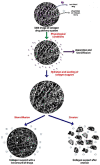Natural-Based Biomaterial for Skin Wound Healing (Gelatin vs. Collagen): Expert Review
- PMID: 34301076
- PMCID: PMC8309321
- DOI: 10.3390/polym13142319
Natural-Based Biomaterial for Skin Wound Healing (Gelatin vs. Collagen): Expert Review
Abstract
Collagen (Col) and gelatin are most extensively used in various fields, particularly in pharmaceuticals and therapeutics. Numerous researchers have proven that they are highly biocompatible to human tissues, exhibit low antigenicity and are easy to degrade. Despite their different sources both Col and gelatin have almost the same effects when it comes to wound healing mechanisms. Considering this, the bioactivity and biological effects of both Col and gelatin have been, and are being, constantly investigated through in vitro and in vivo assays to obtain maximum outcomes in the future. With regard to their proven nutritional values as sources of protein, Col and gelatin products exert various possible biological activities on cells in the extracellular matrix (ECM). In addition, a vast number of novel Col and gelatin applications have been discovered. This review compared Col and gelatin in terms of their structures, sources of derivatives, physicochemical properties, results of in vitro and in vivo studies, their roles in wound healing and the current challenges in wound healing. Thus, this review provides the current insights and the latest discoveries on both Col and gelatin in their wound healing mechanisms.
Keywords: biomaterials scaffolds; collagen; gelatin; in vitro and in vivo; physicochemical property; wound healing.
Conflict of interest statement
The authors declare no conflict of interest. The funders had no role in the design of the study; in the collection, analyses, or interpretation of data; in the writing of the manuscript, or in the decision to publish the results.
Figures
Similar articles
-
Synthesis and Fabrication of Collagen-Coated Ostholamide Electrospun Nanofiber Scaffold for Wound Healing.ACS Appl Mater Interfaces. 2017 Mar 15;9(10):8556-8568. doi: 10.1021/acsami.6b16488. Epub 2017 Mar 1. ACS Appl Mater Interfaces. 2017. PMID: 28221758
-
Accelerated wound healing and its promoting effects of biomimetic collagen matrices with siderophore loaded gelatin microspheres in tissue engineering.Mater Sci Eng C Mater Biol Appl. 2018 Dec 1;93:455-464. doi: 10.1016/j.msec.2018.08.026. Epub 2018 Aug 9. Mater Sci Eng C Mater Biol Appl. 2018. PMID: 30274078
-
Comprehensive Review of Hybrid Collagen and Silk Fibroin for Cutaneous Wound Healing.Materials (Basel). 2020 Jul 10;13(14):3097. doi: 10.3390/ma13143097. Materials (Basel). 2020. PMID: 32664418 Free PMC article. Review.
-
Collagen-based formulations for wound healing: A literature review.Life Sci. 2022 Feb 1;290:120096. doi: 10.1016/j.lfs.2021.120096. Epub 2021 Oct 26. Life Sci. 2022. PMID: 34715138 Review.
-
Collagen from Marine Sources and Skin Wound Healing in Animal Experimental Studies: a Systematic Review.Mar Biotechnol (NY). 2021 Feb;23(1):1-11. doi: 10.1007/s10126-020-10011-6. Epub 2021 Jan 6. Mar Biotechnol (NY). 2021. PMID: 33404918
Cited by
-
Bioinspired Collagen/Gelatin Nanopillared Films as a Potential Implant Coating Material.ACS Appl Bio Mater. 2022 Oct 6;5(10):4913-21. doi: 10.1021/acsabm.2c00633. Online ahead of print. ACS Appl Bio Mater. 2022. PMID: 36203409 Free PMC article.
-
Development of a Composite Hydrogel Containing Statistically Optimized PDGF-Loaded Polymeric Nanospheres for Skin Regeneration: In Vitro Evaluation and Stem Cell Differentiation Studies.ACS Omega. 2024 Mar 19;9(13):15114-15133. doi: 10.1021/acsomega.3c09391. eCollection 2024 Apr 2. ACS Omega. 2024. PMID: 38585049 Free PMC article.
-
Qualitative study on diabetic cutaneous wound healing with radiation crosslinked bilayer collagen scaffold in rat model.Sci Rep. 2023 Apr 19;13(1):6399. doi: 10.1038/s41598-023-33372-z. Sci Rep. 2023. PMID: 37076561 Free PMC article.
-
Bioprinting-By-Design of Hydrogel-Based Biomaterials for In Situ Skin Tissue Engineering.Gels. 2025 Feb 3;11(2):110. doi: 10.3390/gels11020110. Gels. 2025. PMID: 39996653 Free PMC article. Review.
-
A Recent Insight into Research Pertaining to Collagen-Based Hydrogels as Dressings for Chronic Skin Wounds.Gels. 2025 Jul 8;11(7):527. doi: 10.3390/gels11070527. Gels. 2025. PMID: 40710689 Free PMC article. Review.
References
-
- Jackson J.D. Immunology: Host Responses to Biomaterials. In: Lee S.J., Yoo J.J., Atala A., editors. In Situ Tissue Regeneration: Host Cell Recruitment and Biomaterial Design. Elsevier; Amsterdam, The Netherlands: 2016. pp. 35–47.
-
- Biomaterials Market Size, Share & Trends Analysis. [(accessed on 10 June 2021)];2020 :1–190. Available online: https://www.grandviewresearch.com/industry-analysis/biomaterials-industry.
Publication types
LinkOut - more resources
Full Text Sources


